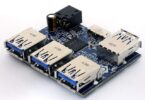Introduction to Neuromorphic Computing
The swift evolution of artificial intelligence (AI) has brought us closer than ever to machines that can learn, adapt, and even think in ways that resemble the human brain. Neuromorphic computing is at the forefront of this transformation. It offers a revolutionary computing model that mimics how the human nervous system processes information.
What is Neuromorphic Computing?
Neuromorphic computing is a fascinating field of technology. It designs hardware and systems inspired by the structure and functioning of the human brain. The traditional computing models are based on the von Neumann architecture. Von Neumann’s architecture separates memory and processing. However, neuromorphic systems aim to integrate memory, processing, and learning in one unified design.
These systems are built using spiking neural networks (SNNs). In these systems, information is transmitted using electrical spikes—just like neurons in the brain.
Key Characteristics:
- Event-driven computation: Responds only to changes in input (like our brain), reducing power usage.
- Massive parallelism: Supports simultaneous operations. That is improving speed and adaptability.
- Low power consumption: Ideal for edge devices and mobile AI.
Comparison Table: Traditional vs. Neuromorphic Computing
| Feature | Traditional Computing (Von Neumann) | Neuromorphic Computing |
| Architecture | CPU ↔ Memory separation | Integrated memory & processing |
| Learning Method | Pre-trained models (offline) | On-chip learning (real-time) |
| Energy Efficiency | High power consumption | Extremely energy efficient |
| Computation Style | Sequential processing | Parallel, event-driven |
| Information Flow | Clock-driven | Spike-driven |
| Application Fit | Cloud, batch tasks | Robotics, IoT, Edge AI |
Simple Diagram: Von Neumann vs. Neuromorphic
Here’s a conceptual illustration:
+———————+ +———————+
| Von Neumann Model | | Neuromorphic Model |
+———————+ +—————————+
| CPU (Processor) | <—> | Neurons (Spiking Units) |
| Memory | | Synapses (Connections) |
| Bus | | Integrated Learning |
+———————+ +—————————+
Neuromorphic chips emulate neural circuits. In which the processing units (neurons) communicate using spikes. That enables low-power and adaptive learning.
Why It Matters in today’s AI Landscape
Modern AI, particularly Deep Learning has made great strides. But it is resource-hungry and not energy-efficient. Models like ChatGPT or autonomous vehicles require massive GPU clusters. That is often out of reach for real-time or mobile applications.
Neuromorphic Computing Offers Solutions:
- Real-Time Processing: Perfect for robotics, autonomous drones, and intelligent sensors.
- Energy-Efficient AI: Crucial for battery-powered or off-grid devices.
- Edge Deployment: Enables smarter IoT systems with on-device intelligence.
Neuromorphic computing is not just an upgrade, it is a paradigm shift. It is mimicking how our brains operate. That opens new possibilities for low-power, adaptive, and intelligent computing critical for the next generation of AI-powered devices.
History of Neuromorphic Computing
Neuromorphic computing is not a new idea. It is a visionary concept that has evolved over decades, rooted in neuroscience, electrical engineering, and computer science. Let us explore how it developed from theory to cutting-edge technology.
-
The Origins: Bridging Biology and Electronics (1940s–1980s)
- 1943 – McCulloch & Pitts Neuron Model
- Walter Pitts and Warren McCulloch created the first mathematical model of a neuron. That lays the groundwork for artificial neural networks.
- 1950s–60s – Hebbian Theory & Early Neural Nets
- Donald Hebb introduced the idea that learning occurs when neurons fire together. That is a foundational principle in neuromorphic learning algorithms.
- 1970s – Analog Circuits Mimicking Neurons
- Early experiments explored analog circuits that could replicate neuron-like behavior. But, they were limited by technology at the time.
-
The Coining of “Neuromorphic” (1980s)
- 1980s – Carver Mead and the Birth of Neuromorphic Engineering
- The term “neuromorphic” was coined by Carver Mead, a Caltech engineer. He envisioned creating chips that emulate the neural architecture of the brain. He was using analog VLSI (Very Large-Scale Integration) systems.
“We should stop trying to force software to think and instead make hardware that works like a brain.” — Carver Mead.
- These early neuromorphic systems focused on the following:
- Sensory processing (vision, hearing)
- Analog circuits with biological fidelity
- Event-driven, low-power behavior
-
Digital Revolution & Hybrid Models (1990s–2000s)
- Neuromorphic concepts are extended into the digital domain for better scalability and control.
- The rise of machine learning diverted attention. However, neuromorphic research quietly progressed in academic labs, especially in Europe (Heidelberg, ETH Zurich).
- The introduction of spiking neural networks (SNNs) added biological realism and fueled new research directions.
-
The Modern Era of Neuromorphic Computing (2010s–Present)
Key Hardware Milestones:
- 2014 – IBM TrueNorth
- A neuromorphic chip with 1 million neurons and 256 million synapses. Highly parallel and energy-efficient.
- 2017 – Intel Loihi
- Intel’s programmable neuromorphic chip with on-chip learning capabilities and real-time processing.
- 2021 – BrainScaleS-2 (Heidelberg)
- An analog-digital hybrid system capable of simulating complex SNNs with extremely low latency.
- 2023 – IBM NorthPole
- A new generation chip combining memory and computing for ultra-low-latency AI with brain-like power efficiency.
Parallel Software Advancements:
- Development of SNN frameworks like NEST, Brian2, SpiNNaker, and Loihi SDK.
- Increased integration of neuromorphic platforms with event-based sensors (DVS cameras).
-
Current Research and Future Directions
Neuromorphic computing is now at the intersection of neuroscience, nanotechnology, and AI. Emerging fields and innovations include:
- Memristive synapses for brain-like memory storage
- Photonic neuromorphic computing using light-based neurons
- Neuro-symbolic systems for combining reasoning with learning
- Use in edge AI, robotics, and prosthetics
Timeline: Milestones in Neuromorphic Computing
| Year | Milestone |
| 1943 | McCulloch-Pitts neuron model |
| 1950 | Hebbian theory of learning |
| 1980s | Carver Mead coins “neuromorphic” and designs analog neuron circuits |
| 2006 | EU BrainScaleS project begins |
| 2014 | IBM launches TrueNorth neuromorphic chip |
| 2017 | Intel unveils Loihi chip |
| 2021 | BrainScaleS-2 released (ETH Zurich + Heidelberg) |
| 2023 | IBM introduces NorthPole: a brain-inspired digital chip with memory |
Core Concepts Behind Neuromorphic Computing
Neuromorphic computing is more than just a new form of hardware. It is a rethinking of how computation should work in an intelligent world. It is taking direct inspiration from the biological brain. The neuromorphic systems aim to replicate cognitive processes like learning, sensing, and adaptation in real-time.
In this section, we will explore the core architectural principles. In addition, we will explain the role of Spiking Neural Networks (SNNs). Further, we will contrast neuromorphic computing with traditional computing models.
Brain-Inspired Architecture and Design
Neuromorphic systems are modeled similar to the human brain’s neural architecture. Conventional computers use a centralized CPU and separate memory. However, in a Neuromorphic system, the brain is a decentralized, parallel, and energy-efficient system. It processes vast amounts of sensory data. Neuromorphic system learns from experience. Further, Neuromorphic system adapts—all at low power.
Biological Inspiration:
In the human brain:
- Neurons act as individual processing units.
- Synapses connect neurons and adapt based on experience (plasticity).
- Spikes (electrical impulses) transmit information between neurons.
Neuromorphic computers emulate this by using:
- Artificial neurons: Digital or analog circuits that mimic neuron behavior.
- Artificial synapses: Elements that store weights or learning rules.
- Spiking signals: Instead of continuous values, computation occurs through discrete spikes—events that carry information across time.
Architectural Principles of Neuromorphic Chips:
- Distributed Memory & Processing: Each neuron can store and process information locally.
- Massive Parallelism: Thousands to millions of neurons operate simultaneously.
- Event-Driven Operation: No central clock—computation only occurs when spikes are triggered.
- On-Chip Learning: Ability to learn in real-time based on local rules (Hebbian learning).
Example:
IBM’s TrueNorth chip uses 1 million neurons and 256 million synapses while consuming only 70 milliwatts—thousands of times more efficient than conventional CPUs.
Spiking Neural Networks (SNNs) Explained
Spiking Neural Networks (SNNs) are at the heart of neuromorphic computing. They are the third generation of neural networks. It follows perceptrons (1st gen) and deep neural networks (2nd gen).
What Makes SNNs Unique?
In SNNs:
- Neurons remain dormant until they receive enough input to “fire” (generate a spike).
- Spikes are binary, time-sensitive events, not continuous values.
- Information is encoded in spike timing, rate, or patterns. That closely resembles biological neural activity.
How a Spiking Neuron Works:
A neuron receives input spikes via synapses. If the cumulative input exceeds a threshold within a short window, the neuron emits a spike. This spike propagates to downstream neurons.
Simple Diagram:
[Input Neuron] ──┐
├──> [Spiking Neuron] —> [Output Spike]
[Input Neuron] ──┘ ↑
(Fires only if input > threshold)
Key Advantages of SNNs:
| Feature | Description |
| Temporal Dynamics | Captures real-time behaviors using spike timing. |
| Low Power Usage | Only active when needed (sparse firing). |
| Event-Based Learning | Supports online, local learning via spike-timing-dependent plasticity (STDP). |
| Noise Tolerance | More robust to noisy or partial input compared to traditional models. |
| Biological Plausibility | Closer to real brain activity. That makes it ideal for cognitive modeling. |
Real-World Use Cases:
- Neuromorphic vision: Event-driven cameras using SNNs for real-time object detection.
- Tactile sensing: Neuromorphic systems can interpret touch and pressure feedback instantly.
- Robotics: Enables energy-efficient control in autonomous machines.
How It Differs from Traditional Computing
The shift from traditional computing to neuromorphic computing is radical and necessary for achieving real-time, energy-efficient intelligence.
Traditional (Von Neumann) Architecture:
- Separated memory and processor.
- Requires continuous shuttling of data (known as the von Neumann bottleneck).
- Ideal for deterministic, clock-driven operations. However, they are not for dynamic, real-world learning.
Neuromorphic Architecture:
- Processing and memory are fused in each neuron-synapse unit.
- Operates asynchronously—only responding to external stimuli.
- Optimized for adaptive, real-time intelligence with minimal power consumption.
Comparison Table: Traditional vs Neuromorphic Computing
| Feature | Traditional Computing | Neuromorphic Computing |
| Architecture | CPU ↔ Memory separation (von Neumann) | Brain-like integrated neurons & synapses |
| Computation Style | Sequential, clock-driven | Parallel, event-driven |
| Learning | Offline training | Real-time, on-chip learning |
| Power Efficiency | High consumption (esp. GPUs/TPUs) | Extremely low—ideal for edge devices |
| Processing Speed | Deterministic, clock-bound | Real-time adaptation to stimuli |
| Best Use Cases | Cloud AI, scientific computing | Robotics, IoT, real-time sensory systems |
| Scalability | Limited by memory bandwidth | Scales naturally with more neurons/synapses |
Supporting Research and Projects:
IBM TrueNorth:
- Introduced in 2014.
- 1 million neurons, 256 million synapses.
- Consumes just 70 milliwatts.
Intel Loihi:
- Introduced in 2018.
- Supports on-chip learning and real-time adaptation.
- Used in robotics, gesture recognition, and more.
Neuromorphic computing is not just a niche idea—it is a revolution in how we design machines to think. By moving beyond traditional limitations, it promises to create AI systems that are not only smarter and more adaptive. However, it is efficient enough to run in the real world, from wearable devices to autonomous robots.
Key Technologies and Components of Neuromorphic Computing
Neuromorphic computing represents a profound shift in the way machines process information. It is moving away from traditional computing paradigms and toward brain-inspired models. This transition is not just theoretical. It is powered by groundbreaking technologies and components that bring neural-like processing into hardware.
In this section, we will explore:
- Neuromorphic chips like Loihi, TrueNorth, and others
- Cutting-edge devices like memristors and synaptic transistors that emulate real brain functions
Neuromorphic Chips: Loihi, TrueNorth, and Others
Neuromorphic chips are specialized processors built to simulate the operation of biological neurons and synapses. In traditional systems CPUs and GPUs execute instructions sequentially or via matrix-based operations. However, these chips employ parallel, event-driven, and spike-based processing.
Let us explore the most prominent neuromorphic chips shaping the future:
-
Intel Loihi
Intel’s Loihi is one of the most advanced neuromorphic chips available. It is designed for research and real-world AI applications that require real-time learning and energy efficiency.
Highlights:
- 130,000 artificial neurons and 130 million synapses
- Built using a 14nm FinFET process
- On-chip learning support for spike-timing-dependent plasticity (STDP)
- Interfaces with conventional systems via PCIe
- Open-source SDK: NxSDK
Use Cases:
- Adaptive control systems
- Robotic navigation
- Sensory processing (vision/audio)
-
IBM TrueNorth
IBM’s TrueNorth chip set the benchmark for neuromorphic computing in 2014. It demonstrated large-scale spiking neural network (SNN) simulation on hardware.
Highlights:
- Simulates 1 million neurons and 256 million synapses
- Composed of 4096 cores, each mimicking 256 neurons
- Exceptionally power-efficient (~70 mW under load)
- Does not support on-chip learning—optimized for inference
Use Cases:
- Image and video recognition
- Sensor data processing
- Machine vision applications
-
SpiNNaker (Spiking Neural Network Architecture)
It is developed at the University of Manchester. SpiNNaker aims to simulate the entire human brain in real time using a network of ARM cores.
Highlights:
- Over 1 million software-based neurons
- Built with ARM968 cores to simulate neural activity
- Optimized for massive parallelism and low latency
Use Cases:
- Neuroscience research
- Brain simulation and modeling
- Cognitive computing
-
BrainScaleS
A neuromorphic platform combining analog and digital technologies. It was developed at Heidelberg University.
Highlights:
- Analog circuits emulate neuron behavior at accelerated speeds (10x–1000x faster)
- Digital back-end for flexibility and control
- Focuses on synaptic learning rules and plasticity
Use Cases:
- Biological modeling
- Temporal dynamics in cognition
Comparison Table of Neuromorphic Chips
| Chip | Developer | Year | Neurons | Synapses | Learning | Power Efficiency | Core Feature |
| Loihi | Intel | 2018 | 130,000 | 130M | On-chip | ~60 mW | Event-driven supports STDP |
| TrueNorth | IBM | 2014 | 1 million | 256M | No | ~70 mW | Scalable mesh architecture |
| SpiNNaker | Univ. of Manchester | 2011 | 1 million+ | Software-based | Yes | ~1W per chip | Real-time simulation via ARM cores |
| BrainScaleS | Heidelberg University | 2011 | Analog model | Varies | Yes | Moderate | Analog-digital hybrid computation |
Memristors and Synaptic Transistors: The Future of Memory
If neuromorphic chips are the brain’s neurons, then memristors and synaptic transistors are its synapses. These components are key to achieving the energy efficiency, learning ability, and scalability of biological systems.
What Is a Memristor?
A memristor is a non-volatile memory device that adjusts its resistance based on the amount and direction of charge that has passed through it. In essence, it remembers past electrical states. That makes it ideal for mimicking biological synapses.
Why Memristors Matter:
- They retain memory without power (non-volatile).
- They emulate synaptic weights—which get stronger/weaker depending on usage.
- They allow analog value storage—ideal for gradient-based learning.
- They operate at nanosecond speeds with extremely low power consumption.
Real-World Progress:
- HP Labs first introduced memristor-based computing in 2008.
- Startups like Knowm Inc. and research from MIT, Stanford, and IBM continue to advance memristor materials and architectures.
Synaptic Transistors: Beyond Traditional Logic
Synaptic transistors are three-terminal devices designed to mimic the adaptable and plastic behavior of biological synapses. They respond to spike-based input and can modulate signal strength in real time. That is critical for dynamic learning systems.
Key Characteristics:
| Feature | Description |
| Three-terminal structure | Input, output, and gate—similar to MOSFETs |
| Learning rule support | Capable of STDP, Hebbian learning, and more |
| Organic and flexible design | Often built from oxide-based or 2D materials |
| Real-time response | Adjusts signal strength based on previous input history |
Organic Synapse Research:
Researchers have developed organic neuromorphic transistors that combine biocompatibility with adaptive learning. It is paving the way for brain-machine interfaces and implantable AI.
How These Technologies Work Together
In neuromorphic systems:
- Neurons are simulated using circuits inside chips like Loihi or TrueNorth.
- Synapses are built using memristors or synaptic transistors.
- The system fires spikes. It adjusts connection strength via synapses and learns from input over time—just like a real brain.
Workflow Diagram:
[Input Stimulus]
↓
[Spiking Neuron (Loihi chip)]
↓
[Synapse (Memristor/Synaptic Transistor)]
↓
[Adaptive Signal Output] → Feedback → Learning Update
Summary Table
| Technology | Role | Key Advantage |
| Neuromorphic Chips | Simulate neurons and networks | Low-power, real-time learning |
| Memristors | Emulate synaptic memory and plasticity | Non-volatile, energy-efficient |
| Synaptic Transistors | Provide dynamic learning and signal modulation | Real-time, analog-like learning |
The fusion of neuromorphic chips with emerging materials like memristors and synaptic transistors forms the backbone of this new computational era. These technologies are not only making machines smarter, they are transforming AI into something more adaptive, efficient, and brain-like than ever before.
Applications and Use Cases of Neuromorphic Computing
Neuromorphic computing is not only a futuristic idea; it is already influencing real-world applications in robotics, IoT, edge computing, and sensory data processing. It is mimicking the brain’s efficiency and adaptability. Neuromorphic systems are unlocking faster, smarter, and more energy-conscious AI solutions.
Let us explore some of the most promising domains:
Real-World Implementations in Robotics and IoT
Neuromorphic systems are ideal for autonomous robots and smart IoT devices, especially where low power consumption, real-time learning, and adaptive behavior are essential.
Neuromorphic Robotics
- Intel’s Loihi-powered robots like the iCub and Nahuku boards demonstrate on-chip learning for adaptive locomotion and real-time decision-making.
- Robots equipped with SNNs can adapt their behavior on the fly. It is learning to navigate, grasp, or avoid obstacles with little training data.
- Neuromorphic vision chips like Prophesee’s event-based sensors allow robots to “see” like a human. It reacts to changes instead of scanning frames.
IoT and Smart Sensors
- In smart homes, neuromorphic chips process sensor input with minimal energy. It is ideal for always-on devices like motion detectors or voice-activated assistants.
- For industrial IoT, neuromorphic processors enable real-time anomaly detection (machinery vibration patterns) without needing cloud processing.
Example:
A Loihi-powered smart door sensor can detect and learn new knock patterns for security access—without sending data to the cloud.
Energy-Efficient Edge Computing
One of the biggest advantages of neuromorphic hardware is its extreme power efficiency. The power efficiency makes it a perfect fit for edge AI.
| Traditional Edge AI (GPU/CPU) | Neuromorphic Edge AI (e.g., Loihi, TrueNorth) |
| High energy consumption | Ultra-low power (<100 mW) |
| Needs cooling infrastructure | No cooling required |
| Inference-only models | On-chip learning and adaptability |
| Limited battery lifespan | Extended uptime, ideal for mobile/remote use |
Use Case Highlights:
- Drones using neuromorphic vision chips can navigate autonomously with limited onboard computers.
- Wearables and medical devices (like neuroprosthetics) use neuromorphic circuits for continuous, on-device brain signal processing.
- In smart agriculture, neuromorphic edge devices detect environmental changes and anomalies in real-time—without needing a network connection.
Real Impact:
A neuromorphic chip can perform gesture recognition at <1 mW, which is 1000x less than a conventional deep learning model on a CPU.
Advancements in Sensory Data Processing
Neuromorphic systems are naturally suited for processing multi-sensory inputs—vision, sound, and touch. This is possible due to their spike-based, asynchronous data handling.
Visual Processing
- Event-based cameras like DAVIS and Prophesee sensors use asynchronous pixels that fire only when they detect changes in light. It is ideal for low-latency vision.
- Paired with neuromorphic processors, these sensors provide:
- Better performance in low-light conditions
- Reduced data bandwidth and energy use
- Faster reaction times (critical in autonomous vehicles)
Auditory Processing
- Neuromorphic chips simulate cochlear dynamics to process sound more efficiently.
- Real-time speech recognition and localization are achieved with far lower energy than conventional models.
- For hearing aids, this means longer battery life and more natural hearing.
Touch and Haptics
- Neuromorphic skin sensors have been created to simulate biological touch perception.
- These sensors encode pressure, vibration, and motion, helping robotic limbs and prosthetics feel and respond naturally.
Example: Use Case Map
[Robotics] [IoT Devices] [Edge AI] [Medical Wearables]
↓ ↓ ↓ ↓
[SNN Learning] [Low Power Sensors] [On-chip Adaptation] [Bio-Signal Processing]
Summary Table of Use Cases
| Domain | Application | Neuromorphic Advantage |
| Robotics | Real-time navigation and adaptive control | Low latency, on-chip learning |
| Smart IoT Devices | Event detection, gesture recognition | Ultra-low power, always-on operation |
| Edge Computing | Surveillance, drones, agriculture | Energy efficiency, local inference |
| Sensory Processing | Vision (event-based), sound, touch | Asynchronous, spike-based data handling |
| Healthcare | Neural interfaces, prosthetics, wearables | Bio-inspired, continuous signal processing |
Neuromorphic computing is redefining the way machines sense, think, and respond. It is capable of bringing brain-like intelligence to devices. That too; it is possible without the cost of cloud computation or massive energy consumption. That makes it one of the most promising technologies for the next generation of AI applications.
Benefits and Challenges of Neuromorphic Computing
Neuromorphic computing offers groundbreaking advantages that traditional systems struggle to match. However, it is not without its hurdles. Understanding the strengths and limitations of this technology is essential for evaluating its future role in AI and computing.
Power Efficiency and Speed: Why Neuromorphic Stands Out
One of the most significant selling points of neuromorphic computing is its brain-like efficiency. Neuromorphic computing achieves faster computation with minimal energy. This is a game-changer in fields where real-time responses and battery-powered devices are essential.
Benefits at a Glance
| Feature | Traditional Computing | Neuromorphic Computing |
| Power Usage | High | Extremely low (<100 mW in Loihi) |
| Processing Style | Synchronous, clock-driven | Asynchronous, event-driven |
| Latency | Noticeable in real-time | Near-instantaneous |
| Learning Capabilities | Inference-only | On-chip learning |
| Energy Cost per Inference | High (GPUs/CPUs) | Ultra-efficient |
Real-World Performance Gains
- Intel Loihi 2: Demonstrated 10x faster and 1000x more energy-efficient performance compared to traditional CPUs on specific SNN workloads.
- Event-based vision systems: Achieve microsecond-level latency. That makes them perfect for autonomous vehicles and robotics.
- Wearables and medical devices can operate longer without frequent recharging. Thanks to the low power draw.
Fun Fact: The human brain runs on ~20 watts. That is less than a dim lightbulb. Neuromorphic chips are designed to mimic this level of energy efficiency.
Scalability and Hardware Limitations: The Other Side of the Coin
The benefits of neuromorphic systems are exciting. However, neuromorphic computing still faces several engineering and adoption challenges that limit its scalability and mainstream use.
Key Challenges
- Limited Ecosystem and Tooling
- Unlike traditional CPUs/GPUs, neuromorphic platforms lack standardized development tools.
- Programming languages and software libraries (PyTorch, TensorFlow) are not fully compatible.
- Requires specialized knowledge of Spiking Neural Networks (SNNs).
- Hardware Availability
- Only a few neuromorphic chips are publicly accessible (Intel Loihi via research programs).
- Devices like IBM TrueNorth and BrainScaleS are research-grade. They are not consumer-grade.
- Integration into existing infrastructures is still complex and niche.
- Scalability Bottlenecks
- Current neuromorphic chips are excellent at specific tasks but not yet general-purpose.
- Scaling SNNs to handle massive datasets is still a work in progress.
- Memory and bandwidth limitations arise due to the event-driven communication model.
Comparison: Traditional vs Neuromorphic Scalability
| Aspect | Traditional Computing | Neuromorphic Computing |
| Hardware Maturity | Decades of refinement | Still in the early stages |
| Compatibility | High with software/tools | Limited (mostly research-based) |
| Large-Scale Data Handling | Well-optimized | Requires novel architectures |
| Chip Production Scale | Mass manufacturing | Prototype/research-level production |
Balancing the Scale: Opportunities vs Challenges
| Benefits | Challenges |
| Ultra-low power consumption | Lack of mainstream hardware access |
| Real-time, adaptive processing | The steep learning curve for developers |
| Ideal for edge AI applications | Tooling and ecosystem are still evolving |
| Inspired by biological systems | Scalability and memory constraints |
Neuromorphic computing offers revolutionary gains in power and speed. However, its future depends on addressing core scalability, accessibility, and tooling challenges. However, as chip design advances and SNN frameworks become more user-friendly. Therefore, we may soon see a surge in neuromorphic adoption across industries.
Neuromorphic vs. Traditional AI Models
Artificial intelligence continues to evolve. Therefore, it is crucial to compare neuromorphic computing with traditional AI models like those run on GPUs and CPUs. Each has unique strengths and weaknesses that make them better suited for specific applications.
Performance Comparison
Traditional AI models like deep neural networks (DNNs) and convolutional neural networks (CNNs) are powered by linear algebra operations and run best on GPUs/TPUs. In contrast, neuromorphic models use spiking neural networks (SNNs) and asynchronous event-driven processing. That is making their computational behavior fundamentally different.
Side-by-Side Performance Table
| Feature/Metric | Traditional AI (GPU/CPU) | Neuromorphic Computing (SNNs) |
| Processing Style | Synchronous, batch-based | Asynchronous, event-driven |
| Power Consumption | High (especially during training) | Extremely low (e.g., <100 mW) |
| Latency | Moderate (depends on model size) | Ultra-low (ideal for real-time use) |
| Learning Style | Backpropagation + gradient descent | Spike-timing-dependent plasticity (STDP) |
| Real-time Adaptability | Limited | High (online, continuous learning) |
| Training Data Requirements | Large datasets | Smaller datasets (still evolving) |
| Hardware Cost | Expensive (GPUs/TPUs) | Lower cost (in long-term deployment) |
| Ecosystem Maturity | Very mature | Still emerging |
Note: Neuromorphic computing lags in general-purpose tasks. However, it is highly optimized for low-power, real-time scenarios—where traditional models fall short.
Where Each Approach Excels
Both neuromorphic and traditional AI systems serve unique niches. Understanding where each shines helps determine which to use—and when to use.
Traditional AI Models Excel At:
- Large-Scale Language Models (LLMs)
- ChatGPT, BERT, and similar models require massive parallel processing.
- Ideal for natural language processing, image generation, and predictive analytics.
- Cloud-Based Applications
- Well-suited for data centers, where energy cost is secondary to performance.
- Leverages established software stacks and community support.
- Static Inference Tasks
- Applications with fixed models and no need for real-time adaptation.
- Works great with pre-trained DNNs on GPUs or TPUs.
Neuromorphic Systems Excel At:
- Real-Time Edge Computing
- Wearables, hearing aids, and autonomous drones need instant decision-making with minimal power.
- SNNs can respond to stimuli faster than traditional models.
- Sensory Data Integration
- Event-based vision (dynamic vision sensors), auditory perception, and tactile sensors.
- Mimics the way the brain processes stimuli.
- Adaptive Robotics
- Neuromorphic systems allow on-the-fly learning and robust control of robots in unpredictable environments.
- Low-Power IoT Devices
- Ideal for remote monitoring systems where battery life and on-device intelligence are critical.
Visual Insight: AI Models vs. Neuromorphic in Action
Here follows a simple illustrative comparison:
+————————–+————————-+
| Feature | Traditional AI Model |
+————————–+————————-+
| Input: Image Frame | Process entire image |
| Processing: CNN | Fixed-size filters |
| Response: Post-analysis | After full pass |
+————————–+————————-+
| Input: Spikes from sensor| Spikes processed live |
| Processing: SNN | Time-sensitive, sparse |
| Response: Instantaneous | On event detection |
+————————–+————————-+
Case Study Example:
Intel’s Loihi chip used in an adaptive robotic arm achieved a 100x improvement in energy efficiency compared to GPU-based control systems while delivering faster reaction times to stimuli like touch and motion.
Hybrid Future? Why Not Both?
As research evolves, many experts believe the future lies in hybrid architectures:
- Neuromorphic cores for real-time sensory feedback
- Traditional AI for complex reasoning and large-scale pattern recognition
This hybrid approach can leverage the best of both worlds. That is especially best suited for next-generation autonomous systems, smart cities, and bio-inspired computing platforms.
Key Characteristics of Neuromorphic Computers
Neuromorphic computers are uniquely designed to emulate the biological brain. Their architecture, processing style, and learning mechanisms differ dramatically from conventional von Neumann systems and even traditional AI accelerators like GPUs.
Here are the defining traits:
-
Brain-Inspired Architecture
- Mimics neurons and synapses using artificial spiking neural networks (SNNs)
- Distributed and parallel structure—much like the human brain
- Processes data through events or spikes, not continuous signals
-
Event-Driven Processing
- Operates asynchronously—only processes data when an event (spike) occurs
- Greatly reduces power consumption and unnecessary computation
- Ideal for real-time sensory systems (vision, sound, touch)
-
Memory and Computation Co-Location
- No clear separation between memory and processing (unlike traditional systems)
- Avoids the von Neumann bottleneck
- Enables faster computation with lower latency and energy cost
- On-Chip Learning Capability
- Supports online, local, and adaptive learning mechanisms
- Can implement Spike-Timing Dependent Plasticity (STDP) and Hebbian learning
- Enables lifelong learning and autonomous adaptation
-
Ultra-Low Power Consumption
- Consumes microwatts to milliwatts for complex tasks
- Suitable for wearables, IoT devices, remote sensors, and robots
-
Massive Parallelism
- Millions of artificial neurons and synapses can fire in parallel
- Offers robust scalability without linear increases in power demand
-
Real-Time Sensory Integration
- Designed to interface naturally with event-based sensors
- Ideal for robotics, prosthetics, drones, and autonomous systems
-
Fault Tolerance and Self-Healing
- Emulates biological resilience: performance degrades gracefully
- Can continue functioning even with partial hardware failures
Summary Table
| Characteristic | Neuromorphic Systems | Traditional Computers |
| Architecture | Brain-inspired, SNN-based | Von Neumann, binary logic |
| Processing | Event-driven, asynchronous | Clock-driven, synchronous |
| Power Efficiency | Very high | Moderate to low |
| Learning Mechanism | On-chip, local learning (e.g., STDP) | Mostly offline via backpropagation |
| Memory-Compute Separation | Co-located | Clearly separated |
| Parallelism | Natural and massive | Limited by architecture |
| Application Focus | Edge AI, sensory tasks, adaptive AI | General-purpose computation |
Neuromorphic Computing and Artificial General Intelligence (AGI)
Artificial General Intelligence (AGI) refers to machines capable of understanding, learning, and applying knowledge across a broad range of tasks like a human. Unlike narrow AI, AGI is not just good at one thing—it must be flexible, adaptive, and context-aware. That is where neuromorphic computing enters the picture.
Why Neuromorphic Computing Matters for AGI
Neuromorphic systems are not just faster or more power-efficient. They are designed from the ground up to mirror the human brain. It is our best working model of general intelligence. Let us break down why this matters:
- Brain-Like Learning Mechanisms
Neuromorphic chips support unsupervised, online learning through biologically inspired models like:
- Hebbian Learning: “Cells that fire together, wire together”
- Spike-Timing Dependent Plasticity (STDP): Learning through timing and frequency of spikes
These enable real-time adaptation and memory formation. That is essential for AGI.
- Lifelong and Continual Learning
Conventional AI models require retraining. However, neuromorphic systems can learn incrementally, much like humans:
- Handle new data without forgetting old tasks (solves catastrophic forgetting)
- Learn from a few examples instead of millions of data points
- Enable contextual learning and self-organization
- Ultra-Efficient Cognition at the Edge
AGI requires brains that can think on their feet, in real-world environments, not just data centers. Neuromorphic computing offers:
- Millisecond-level response times
- Low energy use (ideal for robots, prosthetics, drones, IoT brains)
- High fault tolerance and robustness—key for embodied AGI systems
- Embodied Intelligence and Sensor Fusion
True AGI will likely be embodied (robots or agents) and must process noisy, real-time sensory inputs like vision, sound, and touch.
Neuromorphic platforms naturally integrate with:
- Event-based vision sensors (DVS)
- Auditory processors
- Tactile neural interfaces
This makes them ideal for real-world awareness and interaction, critical traits of AGI.
- Beyond the Limits of Conventional Deep Learning
While deep learning has powered major AI milestones, it still faces bottlenecks in:
- Data inefficiency
- Interpretability
- Energy-hungriness
- Generalization to new domains
Neuromorphic computing offers a fresh architectural approach that may bypass these limitations. It paves the way for more cognitively plausible AI systems.
Summary Table: Neuromorphic vs Deep Learning for AGI
| Aspect | Neuromorphic Computing | Deep Learning (Traditional AI) |
| Learning Style | Online, local, unsupervised | Offline, global, supervised |
| Memory and Adaptation | Real-time, lifelong learning | Static after training |
| Energy Efficiency | Ultra-low power (mW) | High power demand (W to kW) |
| Data Efficiency | Learns from a few examples | Requires massive datasets |
| Sensor Integration | Natively supports event-based sensors | Needs pre-processing |
| Robustness | Fault-tolerant and noise-resilient | Vulnerable to adversarial inputs |
| Suitability for AGI | High potential for embodied, flexible AI | Limited generalization capability |
Can Neuromorphic Computing Lead to AGI?
Neuromorphic computing is not AGI. Yet, it aligns more closely with the architecture and functioning of the human brain than any other computing model we currently have. It is still early. However, with continued research and breakthroughs in synaptic hardware, spiking networks, and self-learning algorithms, neuromorphic systems might bridge the gap between today’s narrow AI and tomorrow’s general intelligence.
If AGI is the destination, neuromorphic computing may be the road less traveled—but the most promising one.
The Future of Neuromorphic Computing
As artificial intelligence pushes beyond conventional boundaries, neuromorphic computing is emerging as a serious contender for shaping the next generation of intelligent systems. Let’s explore the current trajectory and what the future may hold.
Industry Trends and Research Breakthroughs
In recent years, neuromorphic computing has transitioned from a purely academic concept to a field with real-world prototypes, startups, and big-tech investments.
Major Industry Movements
| Company/Institution | Key Contributions |
| Intel | Developed Loihi 1 & 2 chips with real-time SNN learning |
| IBM | Created the TrueNorth chip—1 million neurons, ultra-low power |
| Samsung | Research on neuromorphic vision sensors and memristor arrays |
| SynSense | Commercial edge-AI chips with neuromorphic vision processors |
| BrainChip | Akida platform for ultra-low power edge applications |
Notable Breakthroughs
- Loihi 2 (Intel)
- Up to 10× performance improvement over its predecessor.
- Supports advanced learning rules like STDP and R-STDP.
- Dynamic Vision Sensors (DVS)
- Event-based cameras send information only when movement occurs. That is reducing redundancy and mimicking human eyes.
- Memristor Integration
- Simulates synaptic behavior with non-volatile memory.
- Potential to eliminate the von Neumann bottleneck by co-locating memory and computing.
- SNN Software Frameworks
- The development of open-source tools like NEST, Brian2, and Nengo is making it easier for researchers to simulate and train SNNs.
Is It the Future of Artificial Intelligence?
Neuromorphic computing is not poised to replace traditional AI overnight. It holds the key to expanding AI’s reach into areas currently underserved by deep learning.
Where Neuromorphic Computing Leads the Way
- Energy Efficiency: Up to 1000× more efficient than GPUs for certain tasks.
- Real-Time Responsiveness: Ideal for robotics, IoT, and prosthetics.
- On-Device Intelligence: Perfect for edge computing with limited resources.
- Brain-Computer Interfaces (BCIs): Natural fit for neuromorphic models due to biological compatibility.
Current Limitations Holding It Back
| Challenge | Description |
| Lack of Standardized Frameworks | Still evolving; not as mature as TensorFlow or PyTorch |
| Limited Hardware Availability | Mostly in research labs or early commercial stages |
| Training Complexity | SNN training is still a challenge compared to DNNs |
| Niche Applications | Not ideal for all AI use cases—especially large-scale models |
What the Future Might Look Like
- Hybrid Systems:
- Integration of neuromorphic accelerators alongside traditional processors in AI hardware stacks.
- Autonomous Edge Devices:
- Neuromorphic chips run drones, smart wearables, and environmental sensors independently.
- Neuro-AI Synergy:
- AI models are deeply inspired by cognitive neuroscience. Cognitive neuroscience enables machines to learn and adapt like humans.
- Scalable Architectures:
- Future chips could scale to billions of neurons. They can rival human-brain-like complexity in select domains.
Expert Opinion
“Neuromorphic computing is not about beating GPUs at image classification; it is about enabling entirely new classes of intelligence—adaptable, robust, and efficient.”
— Dr. Mike Davies, Director of Intel’s Neuromorphic Computing Lab
Conclusion: A Brain-Inspired Leap Toward Intelligent Machines
Neuromorphic computing is more than a technological curiosity. It is a paradigm shift in how we think about artificial intelligence. It is mimicking the structure and function of the human brain. Neuromorphic systems promise unmatched efficiency, real-time adaptability, and scalable intelligence in energy-constrained and sensory-rich environments.
We have explored:
- The core concepts like spiking neural networks and brain-inspired architectures
- Pioneering hardware like Intel’s Loihi and IBM’s TrueNorth
- Its real-world impact in edge computing, robotics, and sensory processing
- The advantages in power efficiency and the challenges in scalability
- A comparative lens against traditional AI systems
- And finally, a glimpse into the industry trends and future potential
Neuromorphic computing is still evolving. It is quickly gaining traction across academia and industry. Its promise is not just in outperforming today’s AI but in creating intelligent machines that are fundamentally different—more human, more efficient, and more adaptive.
Is it the future of AI?
Quite possibly, especially as we inch closer to general-purpose AI and seek solutions that can learn, perceive, and decide in the real world without burning through massive computing power.
Technology increasingly pushes the boundaries between biology and silicon. Neuromorphic computing may not just support AI’s future—it might define it.







